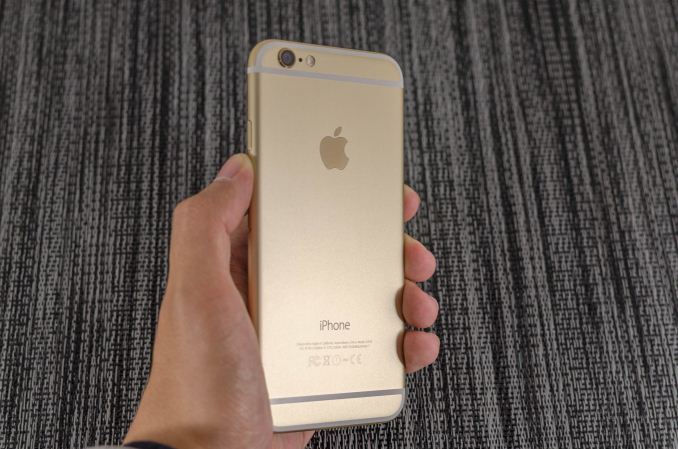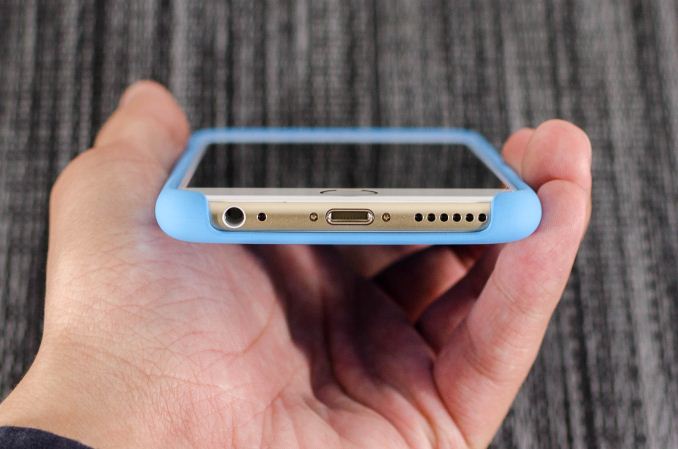The iPhone 6 Review
by Joshua Ho, Brandon Chester, Chris Heinonen & Ryan Smith on September 30, 2014 8:01 AM EST- Posted in
- Smartphones
- Apple
- Mobile
- iPhone 6
Final Words
Overall, the iPhone 6 is a significant step up from the iPhone 5s. One of the first areas where we see noteworthy changes is in the industrial design of the phone. Instead of the hard edges that we saw with the iPhone 5 design, the sides of the phone are now all curved in nature to give much better in-hand feel, and the result is surprisingly appealing as well due to how the glass curves down to meet the metal body. The iPhone 6 is also sitting right around the best balance of display size and one-handed usability, which helps with the in-hand feel aspect. I really have to make it a point to address size in the case of the iPhone 6. While this is definitely a matter of personal opinion and will vary from person to person, I find the size of the iPhone 6 to be refreshing after using phone after phone that pushed display size too far. While Reachability is definitely helpful, the size of the iPhone 6 is such that I really wouldn't miss such a feature on the iPhone 6 because it is an appropriate size. I never really had any issue handling a flagship from 2013 like the Nexus 5, Galaxy S4, G2, or One (M7), so this is a recent issue for me. Those that find those phones to be a good size will likely find the iPhone 6 to be similarly fit for their hands.
While I like the iPhone 6’s industrial design, increasing overall thickness to eliminate the camera hump could be an interesting variation as it would also bring a larger battery. Some users may also dislike the thick plastic lines, though I personally don’t notice this in day to day use.
The display itself is also a solid improvement, with incredible native contrast, high brightness, great viewing angles, and great calibration. I still feel like I’d want higher pixel density to make it the “perfect” display, but it’s clear that there are some very real limitations on resolution selection for iOS devices due to the point system used. Given that the resolution cannot be changed, the iPhone 6’s display is ultimately one of the best I’ve seen all year.
The SoC is also a significant upgrade, although not quite the jump that we saw from A6 to A7. For the most part, the architecture of the new CPU cores is relatively similar and we see a jump in GPU performance that puts the GX6450 on par with the Adreno 420. Apple continues to ship some of the best CPU and GPU choices on the market, and in our GFXBench rundown test it’s obvious that Apple has an extremely efficient system as skin temperatures remain in check while running at maximum performance for the duration of the GFXBench test. It’s clear that the NAND is also of high performance, although random I/O performance isn’t quite as amazing as sequential performance.
In battery life, once again Apple has managed to successfully maintain good battery life despite a relatively small battery capacity. The iPhone 6’s battery life is consistently near the top tier in this category. In the GFXBench rundown where the iPhone 6 falls short it makes up for it with incredible sustained performance.
Outside of the basic user experience, there are still even more improvements. The new camera seems to have better low light performance than before, along with significantly improved focus speed. The continuous auto focus enabled by phase detection autofocus is a killer feature for video when combined with the improved stabilization function. For a relatively small sensor size, Apple has managed to drive performance that rivals the relatively larger cameras of the competition. At the 1/3” sensor size, I’m not aware of a camera that is more balanced in its capabilities for daytime photography, low light photography, and anything in between.
In audio quality, Apple has delivered a solution on par with HTC’s audio solution, which places it among the best for this generation that we’ve tested. While there are some issues, there’s relatively little value to pushing audio quality any further unless high resolution audio becomes common.
Finally, the software experience continues to be great. Apple has taken advantage of the increased display size to increase information density out of the box, and generally improved the polish of iOS with iOS 8. We continue to see strong integration of TouchID into software, and with time I expect to see its value increase even more as Apple Pay and the use of TouchID for third party apps becomes widespread. There are only two significant issues that I noticed in my week with the iPhone 6, and one is because the application was originally intended for iOS 6. The only flaw that the iPhone 6 has is a lack of RAM, and this is only an issue if you also felt it was an issue on the iPhone 5s.
Overall, the iPhone 6 has been a surprise for me. While not all that much changed on the surface, this is the first phone that I’ve reviewed all year where I’ve found more to like the deeper I dug. The iPhone 6 is a great phone in its own right and needs no qualifications in that recommendation. While as a current Android user I’m still reluctant to use the iPhone 6 as my only phone, the iPhone 6 is good enough that I’m willing to consider doing so.













531 Comments
View All Comments
thrasher32 - Tuesday, October 14, 2014 - link
That must be some really good crack there chiefGerryS - Wednesday, October 1, 2014 - link
Absolutely. If it can't be built into the price of the product, there's no incentive to innovate, at all.perpetualdark - Friday, October 3, 2014 - link
Not true, you innovate to stay in the game, not to increase your price point. Part of the "innovation" of the android flagships has been their ability to increase technology, form, and function while reducing or maintaining costs. Both the M8 and the S5 were selling for $99 on contract within a month of launch (by Verizon). Apple might have sold a lot of phones in this launch, but that was mostly due to the fact that there hasn't been an "innovation" in several years, and very little reason to buy an Apple product for at least 2 generations. Just keep watching to see how sales hold up after the initial storm is passed. In a few months when you can buy an S5 or M8 for $99 on contract, or an iPhone for $299, which do you think will sell better? And in 6 months, both companies will have the next gen of flagship out, with superior specs across the board and will launch at the same price as Apple, because the iphone 6 will STILL be $299.bigstrudel - Tuesday, September 30, 2014 - link
Samsung uses Off-the-shelf SoC's for every flagship device outside of Korea. Nothing impressive about that.techconc - Thursday, October 2, 2014 - link
@danbob999 - Samsung's SoC designs are basically equivalent to Apple's early A4 and A5 work. They essentially just use off the shelf reference designs and put them together to meet their own specifications. Yes, there is some work involved with doing that, but to date, this hasn't been a competitive advantage for Samsung like it has for Apple. In fact, Samsung ends up using Qualcomm chips for a very large percentage for their devices. Likewise, putting them in the same league as what Apple, Qualcomm or even nVidia is doing isn't quite right. They're not in the same league design wise.Samsung attempts to add layers of customization (Touchwiz, etc.) on top of Android, but it just feels like a clumsy layer on top and ends up dropping performance and resources for the device overall. Such customizations are no substitute for writing your own OS and controlling the entire technology stack. That's why a Samsung phone will always feel clumsy as compared to an iPhone. Samsung would have to to the Tizen route to attempt to compete on that level.
Chaser - Wednesday, October 1, 2014 - link
Now this is amusing. The OS hasn't changed since it launch except for, wait for it: pull down notifications! Amazing. But seriously its the same floating blobs that sit in rows on a screen. Designed for teenagers and grandparents in mind.techconc - Thursday, October 2, 2014 - link
@Chaser - Thanks for sharing your ...wait for it... ignorance on OS design and what's actually changed over the years. It should suffice to say that you clearly don't know what you're talking about.shm224 - Thursday, October 2, 2014 - link
@techconc : Sure, would you mind giving us some examples of such "changes" in iOS?techconc - Monday, October 6, 2014 - link
@shm224 - LOL! Not interested in doing a commercial for Apple and the listing surely wouldn't fit in a forum post. Google is your friend... If you're really interested, you can start with something like the Wikipedia entry for iOS and of course consult the release notes for each iOS release on Apple's developer site.michael2k - Thursday, October 2, 2014 - link
What? It gained an app store, popup notifications, printing, multitasking, search, pull down notifications, pull up settings, folders, multiple homescreens, enhanced notifications (reply, dismiss, widgets), and file sharing.